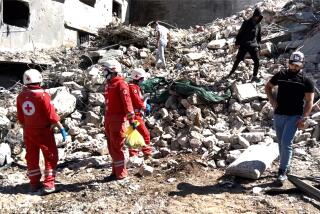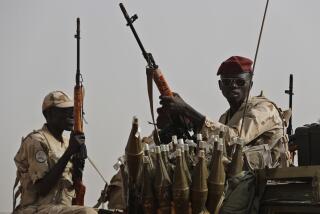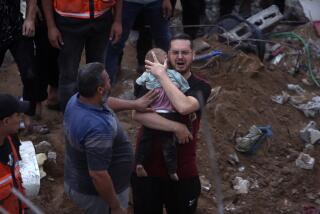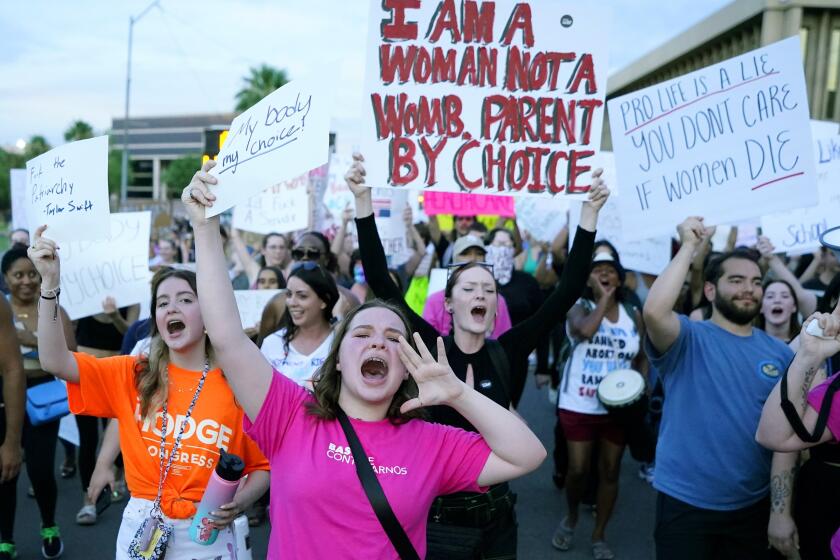About 30 children slain in Syria
BEIRUT — The blood-spattered children lie on a patterned rug, their wounds graphic proof that youth offers no protection from the dark forces unleashed in Syria.
An unidentified man picks up the limp corpse of one boy, displaying the battered remains for the camera. He puts the child down and hoists another lifeless young body aloft.
“Massacre in Houla -- all children!” someone is heard shouting amid groans of agony and disbelief.
The grisly scenes posted online Saturday from Houla, a township in Homs province, drew international condemnation and in the view of some, have the potential to become a turning point in the 14-month rebellion against the government of President Bashar Assad.
The United Nations said that more than 90 people, more than one-third of them children, had been killed in what appeared to be the worst violence against civilians in Syria since a U.N.-backed cease-fire went into effect last month.
The U.N. confirmed the use of artillery and tank shells, strongly suggesting the involvement of government forces. The killings occurred during a government offensive Friday and early Saturday, opposition activists said. Ground forces entered the town after the shelling to finish off the victims, the opposition alleged.
The official government news agency blamed “armed terrorists” linked to Al Qaeda for the killings in an area that long has been at the epicenter of the revolt against Assad.
U.N. monitors have been unable to quell the violence, but their presence in Houla after the killings in Houla left no doubt that something horrible had happened.
In another video, blue-helmeted observers were shown viewing corpses wrapped in sheets and laid out on the floor of what appeared to be a mosque. One observer could be seen photographing the remains as people pulled the covers from the faces of the dead.
The killings were “indiscriminate,” Maj. Gen. Robert Mood, chief of the U.N. team in Syria, said in Damascus, the Syrian capital.
“The deaths of 32 young children, the future of Syria, is something that is absolutely ... unforgivable,” a somber Mood said.
A subsequent statement from U.N. Secretary-General Ban Ki-moon and Kofi Annan, the U.N.-Arab League special envoy for Syria, hinted strongly at government culpability. An investigation found that “artillery and tank shells were fired at a residential neighborhood,” the statement said. Such heavy weaponry is regularly employed by the Syrian military, but not widely available to rebels.
“This appalling and brutal crime involving indiscriminate and disproportionate use of force is a flagrant violation of international law and of the commitments of the Syrian government to cease the use of heavy weapons in population centers and violence in all its forms,” the two officials said. “Those responsible for perpetrating this crime must be held to account.”
Outrage over the deaths of so many children may drive demands for more international action. The opposition called for an emergency U.N. meeting, even as Annan was scheduled to visit Damascus this week.
Juan Cole, a University of Michigan historian and prominent commentator on Middle Eastern affairs, suggested in a blog post that Houla could become a decisive event in Syria comparable to the My Lai massacre in Vietnam.
“Just as the U.S. public began turning against the Vietnam War because of events like the My Lai massacre, so Houla could be a turning point,” Cole wrote.
However, Assad is widely thought to maintain considerable support in Syria, especially among Christians and other minorities, notably members of his own Alawite sect, an offshoot of Shiite Islam, who hold important posts in the security services and the military. Many fear that Assad’s fall could usher in a Muslim fundamentalist government and the kind of instability that grips neighboring Iraq.
Assad also enjoys the backing of Russia and China, permanent members of the U.N. Security Council. Both support the peace initiative headed by Annan, but have vetoed Security Council resolutions critical of Assad.
The state-controlled Syrian news media also broadcast graphic images of the children’s corpses, but blamed “Al Qaeda-linked terrorist groups” for the killings. The official Syrian Arab News Agency said “terrorist” groups had burned houses and crops in a bid to put the blame on the army.
Each side regularly accuses the other of committing massacres of civilians in a conflict that has left at least 10,000 people dead. The government has limited access to foreign observers and journalists, making it difficult to determine who is behind most of the killings.
--
Special correspondent Marrouch reported from Amman, Jordan. Special correspondent Alexandra Sandels in Beirut contributed to this report.
More to Read
Sign up for Essential California
The most important California stories and recommendations in your inbox every morning.
You may occasionally receive promotional content from the Los Angeles Times.










